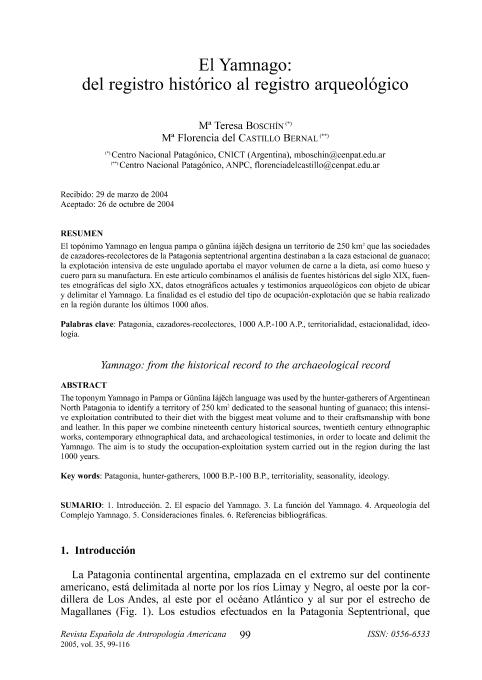Artículo
El topónimo Yamnago en lengua pampa o gününa iájëch designa un territorio de 250 km2 que las sociedades de cazadores-recolectores de la Patagonia septentrional argentina destinaban a la caza estacional de guanaco; la explotación intensiva de este ungulado aportaba el mayor volumen de carne a la dieta, así como hueso y cuero para su manufactura. En este artículo combinamos el análisis de fuentes históricas del siglo XIX, fuentes etnográficas del siglo XX, datos etnográficos actuales y testimonios arqueológicos con objeto de ubicar y delimitar el Yamnago. La finalidad es el estudio del tipo de ocupación-explotación que se había realizado en la región durante los últimos 1000 años. The toponym Yamnago in Pampa or Gününa Iájëch language was used by the hunter-gatherers of Argentinean North Patagonia to identify a territory of 250 km2 dedicated to the seasonal hunting of guanaco; this intensive exploitation contributed to their diet with the biggest meat volume and to their craftsmanship with bone and leather. In this paper we combine nineteenth century historical sources, twentieth century ethnographic works, contemporary ethnographical data, and archaeological testimonies, in order to locate and delimit the Yamnago. The aim is to study the occupation-exploitation system carried out in the region during the last 1000 years.
El Yamnago: del registro histórico al registro arqueológico
Título:
Yamnago: from the historical record to the archaeological record
Fecha de publicación:
01/2005
Editorial:
Universidad Complutense de Madrid
Revista:
Revista Española de Antropología Americana
ISSN:
0556-6533
Idioma:
Español
Tipo de recurso:
Artículo publicado
Clasificación temática:
Resumen
Archivos asociados
Licencia
Identificadores
Colecciones
Articulos(CCT-CENPAT)
Articulos de CTRO.CIENTIFICO TECNOL.CONICET - CENPAT
Articulos de CTRO.CIENTIFICO TECNOL.CONICET - CENPAT
Citación
Boschin, Maria Teresa; del Castillo Bernal, María Florencia; El Yamnago: del registro histórico al registro arqueológico; Universidad Complutense de Madrid; Revista Española de Antropología Americana; 35; 1-2005; 99-116
Compartir




